Visualization techniques play a crucial role in converting complex data into clear and accessible formats, enhancing understanding and engagement. Methods such as data visualization, infographics, and interactive dashboards not only simplify information but also empower users to make informed decisions by quickly identifying trends and insights.
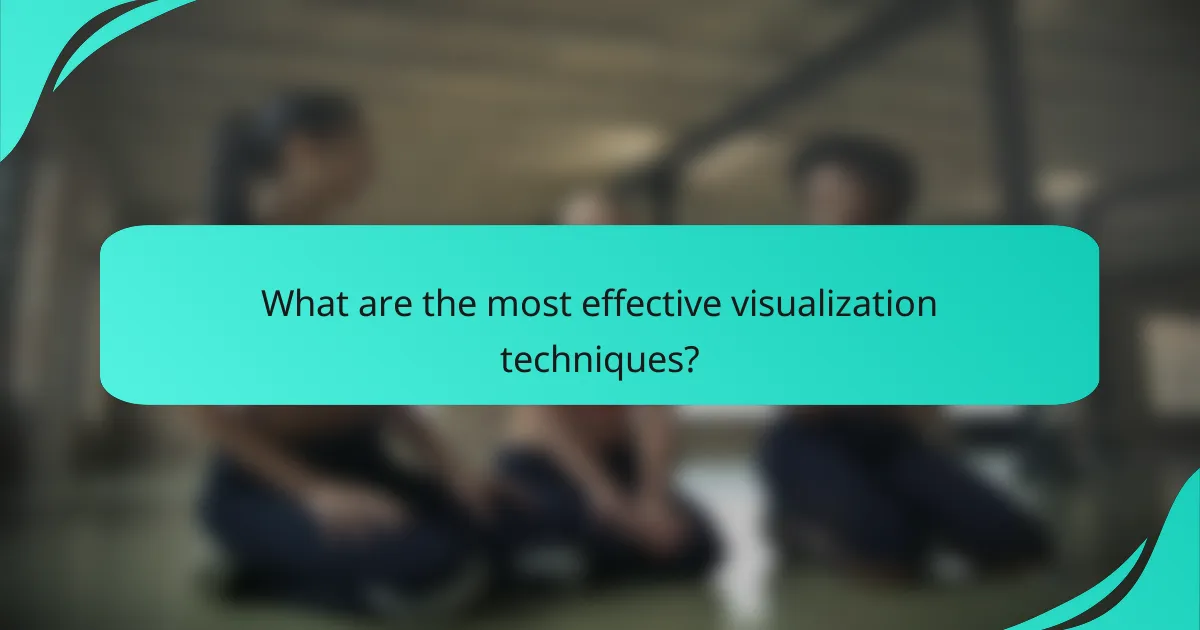
What are the most effective visualization techniques?
Effective visualization techniques transform complex data into clear, understandable formats. The best methods include data visualization, infographics, interactive dashboards, heat maps, and 3D modeling, each serving unique purposes and audiences.
Data visualization
Data visualization involves representing data through graphical formats like charts, graphs, and maps. This technique helps identify trends, patterns, and outliers, making it easier to analyze large datasets. Common tools for data visualization include Tableau, Microsoft Power BI, and Google Data Studio.
When using data visualization, focus on clarity and simplicity. Avoid cluttered designs and ensure that the most important information stands out. A good rule of thumb is to limit the number of colors and elements to enhance readability.
Infographics
Infographics combine text and visuals to present information succinctly and engagingly. They are particularly effective for storytelling, making complex data more digestible for a broad audience. Infographics can be used in reports, presentations, and social media to convey messages quickly.
To create effective infographics, prioritize key data points and use visuals that complement the narrative. Tools like Canva and Piktochart can help design infographics easily. Remember to cite sources and maintain a logical flow to keep the audience engaged.
Interactive dashboards
Interactive dashboards allow users to explore data dynamically, providing real-time insights through filters and drill-down features. These dashboards are valuable for monitoring key performance indicators (KPIs) and making data-driven decisions. Popular platforms include Tableau and Qlik Sense.
When designing interactive dashboards, ensure that they are user-friendly and intuitive. Use clear labels and logical layouts to guide users. Regularly update the data to maintain relevance and accuracy, and consider user feedback for continuous improvement.
Heat maps
Heat maps visualize data density or intensity across geographical areas or within datasets, using color gradients to represent values. They are useful for identifying hotspots and trends in data, such as customer behavior or resource allocation. Heat maps can be created using tools like Google Maps or specialized software.
To effectively use heat maps, select appropriate color schemes that enhance understanding without causing confusion. Ensure that the underlying data is accurate and up-to-date to avoid misleading interpretations. Consider the audience’s familiarity with the data when presenting heat maps.
3D modeling
3D modeling creates three-dimensional representations of data, allowing for a more immersive analysis experience. This technique is particularly useful in fields like architecture, engineering, and scientific visualization. Software such as Blender and SketchUp can facilitate 3D modeling.
When employing 3D modeling, keep in mind the complexity of the models and the potential for information overload. Use 3D visuals to highlight specific features or relationships within the data, and ensure that the models are easily navigable for the audience. Consider the context and purpose of the visualization to determine if 3D is necessary or if simpler formats would suffice.
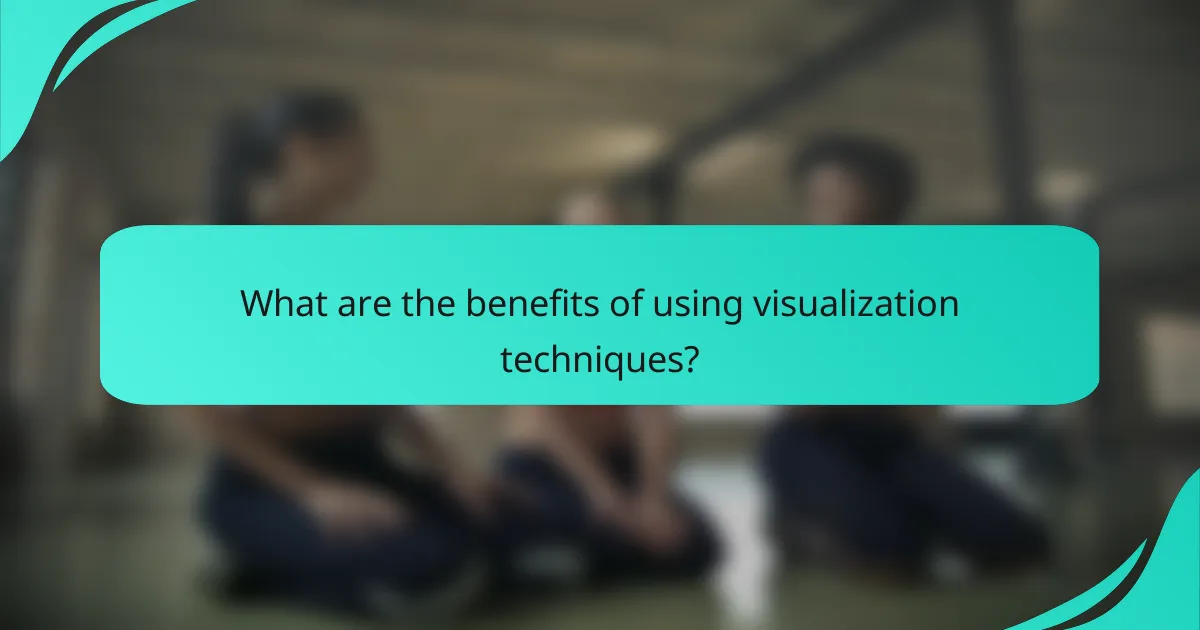
What are the benefits of using visualization techniques?
Visualization techniques provide clear advantages by transforming complex data into easily digestible formats, enhancing comprehension and engagement. They facilitate better decision-making by presenting information visually, allowing users to quickly grasp insights and trends.
Enhanced understanding
Visualization techniques enhance understanding by simplifying complex information. When data is represented visually, such as through charts or graphs, it becomes easier to identify patterns and relationships that might be overlooked in raw data. For instance, a line graph can quickly show trends over time, making it more accessible than a table of numbers.
Using color coding and interactive elements can further improve clarity, allowing users to focus on specific data points. This approach is particularly useful in fields like education and business, where clear communication of information is crucial.
Improved decision-making
Effective visualization techniques lead to improved decision-making by providing stakeholders with clear insights. When data is presented visually, it allows decision-makers to quickly assess situations and make informed choices. For example, a dashboard displaying key performance indicators (KPIs) can help managers identify areas needing attention at a glance.
Moreover, visualizations can highlight potential risks and opportunities, enabling proactive strategies. It’s essential to ensure that visualizations are accurate and relevant to avoid misleading conclusions.
Increased engagement
Visualization techniques can significantly increase engagement by making data more appealing and interactive. Engaging visuals capture attention and encourage users to explore the information further. For instance, interactive infographics allow users to manipulate data points, fostering a deeper understanding of the subject matter.
Incorporating storytelling elements into visualizations can also enhance engagement. By presenting data within a narrative context, users are more likely to connect with the information and retain it longer.
Faster data analysis
Using visualization techniques accelerates data analysis by enabling quicker interpretation of large datasets. Visual tools can condense vast amounts of information into concise formats, allowing analysts to identify trends and anomalies rapidly. For example, heat maps can reveal areas of high activity in a dataset, streamlining the analysis process.
To maximize efficiency, it’s important to choose the right type of visualization for the data being analyzed. Simple bar charts or pie charts may suffice for basic comparisons, while more complex datasets may require advanced visualizations like scatter plots or network diagrams.
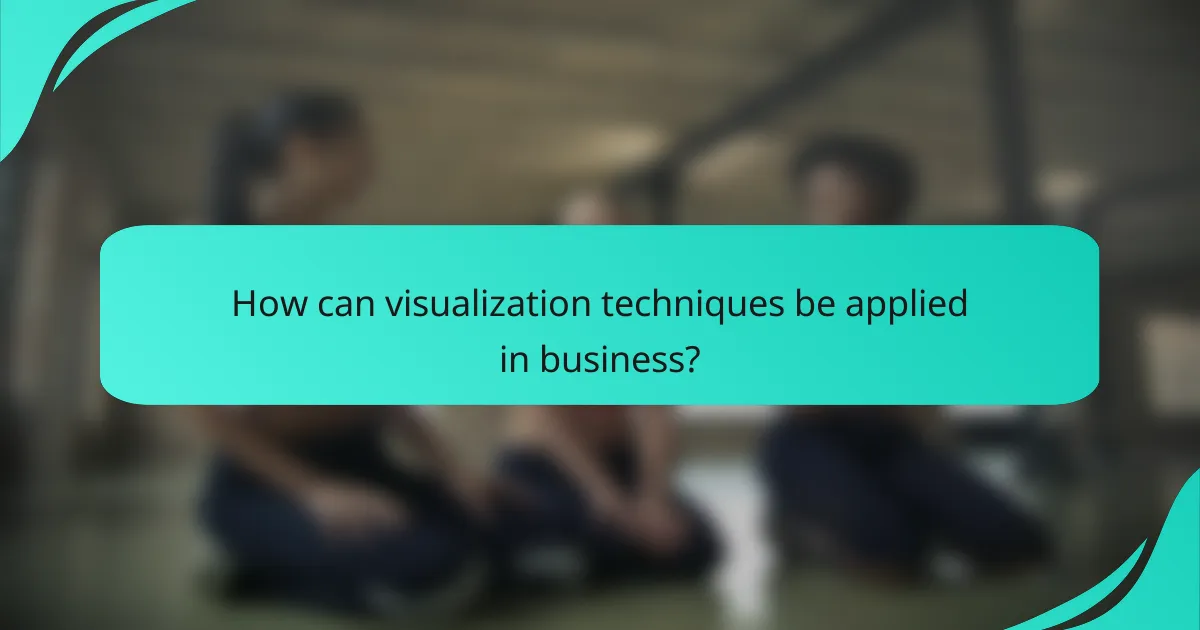
How can visualization techniques be applied in business?
Visualization techniques can enhance business decision-making by transforming complex data into clear, actionable insights. By using charts, graphs, and dashboards, organizations can quickly identify trends and patterns that inform strategy and operations.
Marketing analytics
In marketing analytics, visualization techniques help businesses track campaign performance and customer engagement. Tools like heat maps and funnel charts allow marketers to see which channels drive the most traffic and conversions, enabling them to allocate resources effectively.
For example, a company might use a bar chart to compare the performance of different advertising platforms, identifying which yields the highest return on investment (ROI). This visual representation can guide future marketing strategies and budget decisions.
Sales performance tracking
Sales performance tracking benefits significantly from visualization techniques, as they provide a clear overview of sales metrics. Dashboards displaying key performance indicators (KPIs) such as sales volume, revenue growth, and conversion rates help sales teams monitor their progress against targets.
Utilizing line graphs to illustrate sales trends over time can highlight seasonal fluctuations and inform inventory management. Regularly updating these visuals ensures that the sales team remains aligned with their goals and can adjust tactics as needed.
Customer insights
Visualization techniques are crucial for gaining customer insights, allowing businesses to analyze demographics, preferences, and behavior patterns. Tools such as pie charts and scatter plots can reveal customer segments and their purchasing habits, guiding product development and marketing efforts.
For instance, a company might use a segmented bar chart to visualize customer satisfaction scores across different demographics, identifying areas for improvement. This targeted approach can enhance customer experience and loyalty.
Financial reporting
In financial reporting, visualization techniques simplify the presentation of complex financial data, making it easier for stakeholders to understand. Common visuals include balance sheets, income statements, and cash flow charts that highlight key financial metrics.
Using a combination of tables and graphs can provide a comprehensive view of a company’s financial health. For example, a line graph showing revenue growth alongside a bar chart of expenses can help identify profitability trends and inform strategic financial planning.
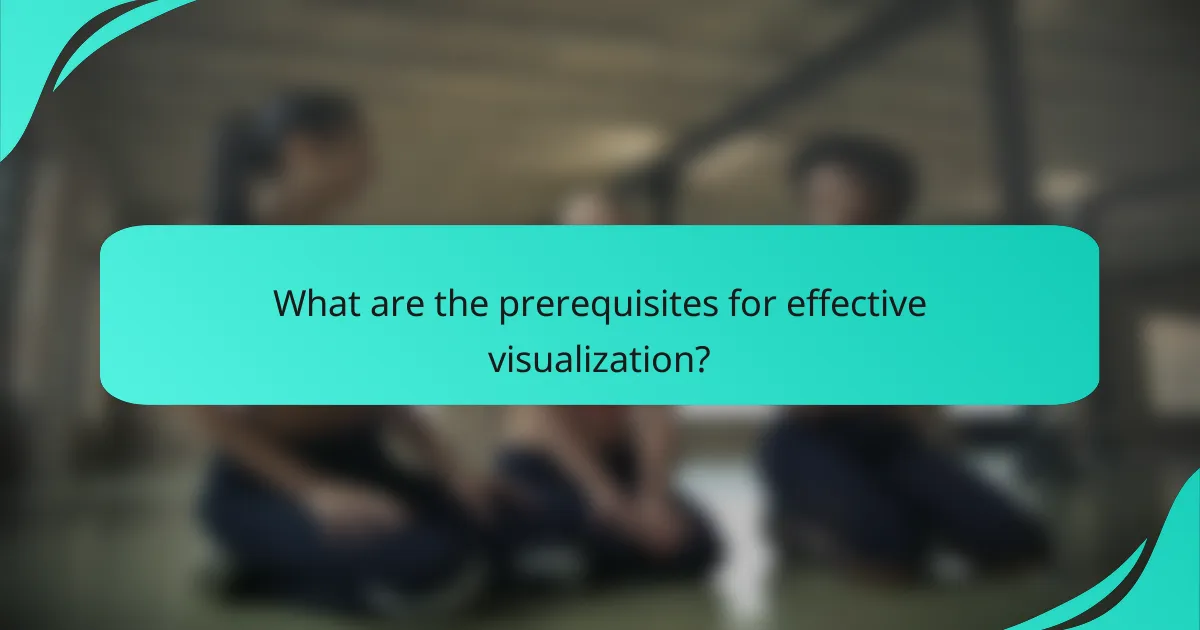
What are the prerequisites for effective visualization?
Effective visualization requires high-quality data, clear objectives, and a solid understanding of the audience. These elements ensure that the visual representation communicates the intended message accurately and effectively.
Data quality
Data quality is crucial for effective visualization. It involves ensuring that the data is accurate, complete, and relevant to the objectives of the visualization. Poor data can lead to misleading insights and incorrect conclusions.
To maintain data quality, regularly validate and clean your data sources. This may include checking for duplicates, filling in missing values, and ensuring consistency in data formats. Aim for data that is up-to-date and reflects the current situation.
Clear objectives
Establishing clear objectives is essential for guiding the visualization process. Define what you want to achieve with the visualization, whether it’s to inform, persuade, or explore data. This clarity helps in selecting the right type of visualization and the data to include.
Consider using the SMART criteria (Specific, Measurable, Achievable, Relevant, Time-bound) to frame your objectives. This approach can help ensure that your visualization is focused and effective in conveying the desired message.
Audience understanding
Understanding your audience is vital for creating effective visualizations. Different audiences may have varying levels of expertise and familiarity with the subject matter. Tailoring the visualization to their needs can enhance comprehension and engagement.
Conduct audience research to identify their preferences and knowledge levels. Use appropriate terminology and visual complexity based on their background. For instance, a technical audience may appreciate detailed charts, while a general audience might benefit from simpler visuals with clear explanations.
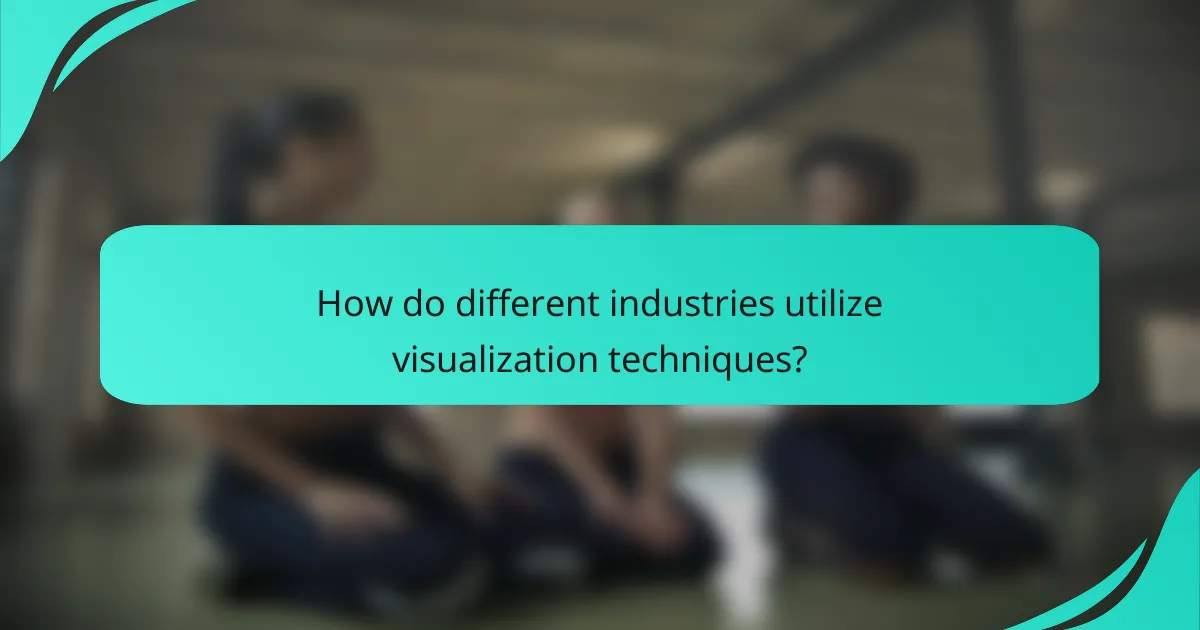
How do different industries utilize visualization techniques?
Various industries leverage visualization techniques to enhance data interpretation and decision-making. By transforming complex data into visual formats, organizations can quickly identify trends, patterns, and insights that drive their operations.
Healthcare data visualization
In healthcare, data visualization is crucial for monitoring patient outcomes, managing resources, and improving treatment protocols. Visual tools like dashboards can display patient metrics, treatment effectiveness, and hospital performance indicators, allowing healthcare professionals to make informed decisions swiftly.
For instance, hospitals often use heat maps to visualize infection rates across different departments, enabling targeted interventions. Additionally, visualizing patient demographics can help in resource allocation and identifying health disparities.
Education and training
Education sectors utilize visualization techniques to enhance learning experiences and improve retention. Tools such as interactive charts and infographics can simplify complex concepts, making them more accessible to students of all ages.
For example, educators might use visual aids like timelines to illustrate historical events or flowcharts to explain scientific processes. Incorporating these techniques into training programs can significantly boost engagement and comprehension.
Financial services
In financial services, visualization techniques are essential for analyzing market trends, assessing risks, and making investment decisions. Financial analysts often rely on graphs and charts to present data on stock performance, economic indicators, and portfolio allocations.
Common visual tools include candlestick charts for stock prices and pie charts for asset distribution. By employing these visualizations, financial professionals can quickly interpret data, identify investment opportunities, and communicate insights effectively to clients.
